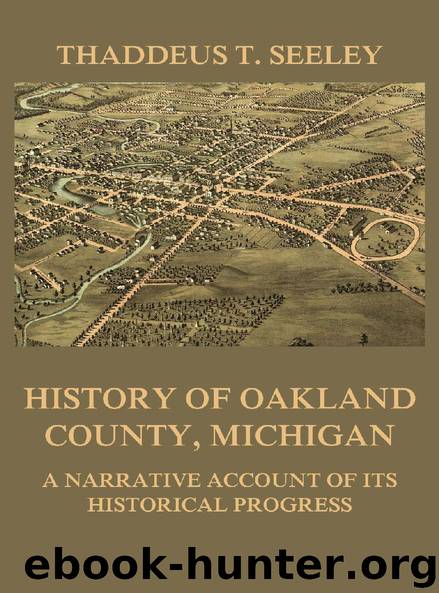History of Oakland County, Michigan by Thaddeus D. Seeley

Author:Thaddeus D. Seeley [Seeley, Thaddeus D.]
Language: eng
Format: epub
Tags: Geschichte
Publisher: Jazzybee Verlag
Published: 2018-03-19T23:00:00+00:00
CHAPTER XVI. BANKS AND BANKING
In consideration of its population and undeveloped condition in the late thirties, Oakland county had its full share of experience in "wild-cat banking," and all that the expression implies. As in other sections of Michigan, the banks of that period were largely the mediums through which it was excepted to develop the canal and railroad enterprises included in the grand state scheme of internal improvements. The proposed improvements were ahead of the times and far in advance of the available funds to carry them out; and when the railroads and other improvements flattened out, in their initial stages, the banks went with them.
Oakland County's First Bank
The first bank of issue established in Oakland county was the Bank of Pontiac, which was established on a franchise of the Detroit & Pontiac Railroad Company and authorized by the charter of that corporation approved March 26, 1835, which allowed the incorporators, or their successors, to found a bank of issue under the foregoing name, with a capital of $100,000. The books for the subscription to the capital stock of the bank were opened on the 26th of May, 1835, in Pontiac, and the whole amount, less $10,000, taken, and the required ten per cent in cash paid in during the same day. Banknotes were shortly afterward put into circulation. During the suspension of specie payments, in the panic of 1837, the Bank of Pontiac redeemed its bills in specie for a time, after all the other banks in the state had suspended. It finally collapsed, was revived for a short period by Joseph Dows and E. B. Cornstock, and then really died.
The "Wild-Cat" Banks
The general banking law of 1837, which specifically produced the "wild-cat" system, brought six failures to the banks of Oakland county. The first was founded in July of that year and was called the Bank of Oakland. It had a capital of $50,000, and its board of directors was as follows: Daniel LeRoy, president; G. O. Whittemore, cashier; Schuyler Hodges, C. C. Hascall, Amasa Bagley, Olmstead Chamberlain, G. W. Williams and Francis Darrow, directors.
This was soon followed by another called the Farmers' & Mechanics' Bank, with a capital of $50,000, of which Schuyler Hodges was president, G. W. Williams, cashier; and G. O. Whittemore, teller.
In December, 1837, the Clinton Canal Bank was established with the same amount of capital — William S. Stevens, president, and Alfred Treadway, cashier.
In the early part of 1838 the Farmers' Bank of Oakland and the Bank of Auburn, each capitalized at $50,000, were established, and at once proceeded to pour into the market their promises to pay, which the good citizens trustfully received as real money.
But the circulatory power of the "wild-cat" banks proved to be of short duration, as they all suspended payment in 1838, on the decision of the supreme court relieving the stockholders from any liability touching the redemption of the bank bills.
The Clinton Canal Bank was reported in good standing with the state institutions in June, 1838, but in October it was enjoined against further operations, and S.
Download
This site does not store any files on its server. We only index and link to content provided by other sites. Please contact the content providers to delete copyright contents if any and email us, we'll remove relevant links or contents immediately.
Twilight of the Idols With the Antichrist and Ecce Homo by Friedrich Nietzsche(17709)
CHERUB: The Recruit by Robert Muchamore(1828)
CHERUB: The Fall by Robert Muchamore(1712)
CHERUB: Man vs Beast by Robert Muchamore(1611)
I Capture the Castle by Dodie Smith(1574)
The Edge of the Abyss (Sequel to The Abyss Surrounds Us)(1468)
Black Genesis by Robert Bauval(1319)
A Brief History of Everyone Who Ever Lived by Adam Rutherford(1249)
all by Unknown Author(1243)
Where Do I Start? by Chase Taylor Hackett(1061)
2016 Baby Names Almanac(978)
Painfully Rich by John Pearson(958)
Genetics by Adam Rutherford(922)
How to Argue With a Racist by Adam Rutherford(882)
2011 Baby Names Almanac(842)
Black Hawk Down by Mark Bowden(829)
It's All Relative by A. J. Jacobs(799)
My European Family by Karin Bojs(787)
Spook Street (Slough House) by Mick Herron(781)
